

What do you see when you go on a research cruise?
This is the most common question I get asked when I enthusiastically tell stories of our adventures at sea. For most people, the word “cruise” means travelling from one place to another (often islands or coastal cities) by sea. Our research cruise apparently has only one destination: the ocean (when we are lucky we are trying to get close to a float, that is moving in the ocean). No islands, no fishermen villages, no coastal party towns: just water everywhere. Isn’t it a boring view?
Different people may have different views on the subject, but my answer is without question a solid “no!”. And it’s not just because of the incredible wildlife that we get to encounter sometimes in the open ocean (we have been lucky to come across pilot whales and a range of seabirds), the beautiful dark skies at night and the sunsets, but mostly because of the ocean itself. Every day the ocean is different: the waves are different, the rhythm at which it shakes you out of bed or gently rocks you into sleep is different, the white caps patterns in the water are different and the color can be very different because of the color of the sky and the amount of sediments or phytoplankton in the water. When we left San Juan, Puerto Rico, the water was an energetic, smooth, solid blue, while in the northern stations that we reached the color was ranging between a silver-looking gray (on cloudy days) and a greenish aqua color. Right now – 3 a.m., it’s plain black. Ok, maybe that’s cheating.

Views from our flight from Dallas, TX to San Juan, Puerto Rico. On the left, differences in ocean color near some Caribbean’s’ islands. On the right, a sediment-rich river plume (possibly from the Mississippi River) encounters the Gulf of Mexico blue waters.
These differences in color are not just a treat for salty fishermen, oceanographers and sailors, but can be detected from planes and even satellites equipped with special sensors (and some very good images can be found here: https://oceancolor.gsfc.nasa.gov/)! When clouds do not cover the surface of the ocean, it is possible to use the color of the ocean to study the distribution of sediments and chlorophyll abundance in the ocean (and this can be used to estimate how much phytoplankton is there). Indeed, many satellite oceanographers spend years studying maps of “how green and how blue is the ocean” and how such maps change between years, seasons and different regions. Maps of this kind also helped us planning our samples, to make sure that we observe the different oceanographic conditions that characterize the North Atlantic: areas that can be as different as a forest from a desert can be just a few currents (and hundreds of km) away and if we want to understand anything about the ocean, we need all the help that we can get!
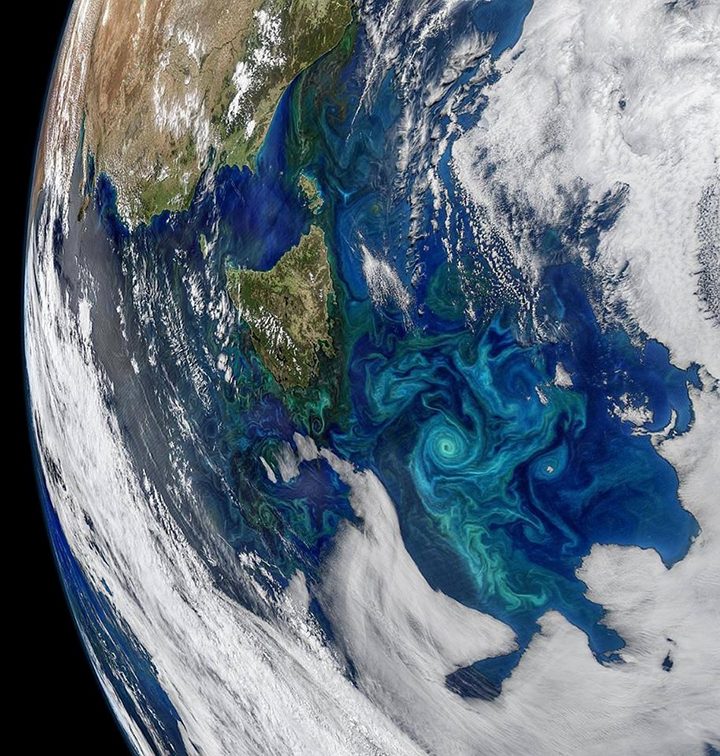
A satellite image of surface chlorophyll off the coast of Tasmania, Australia, highlights how different can be the color of the ocean even within a few hundreds of kilometers of distance. (NASA)
Written by Alice Dellapenna
Never Boring
“Wow, what an exciting life you lead” is a seemingly cliché response I get when the topic of what I do for a living comes up in casual conversation with strangers. I know for a fact (from having to clarify enough times, as I’m sure everyone aboard has also) that those people envision a cruise departing from Puerto Rico to entail some sort of warm, tropical, Steve Zissou-esque adventure, a life of freedom upon the open ocean, studying the dolphins that happen to swim by, sipping cocktails after work, visiting exotic countries, basically anything just short of playing shuffleboard up on the lido deck, because, you know, it is a job after all. If you’ve been following this blog, you’ve already gotten a hearty sense that those kind of Instagrammable moments, drinking coffee and watching the sunrise, is punctuated by the other 23 hours and 55 minutes a day of exhausting, dedicated work to the science mission.
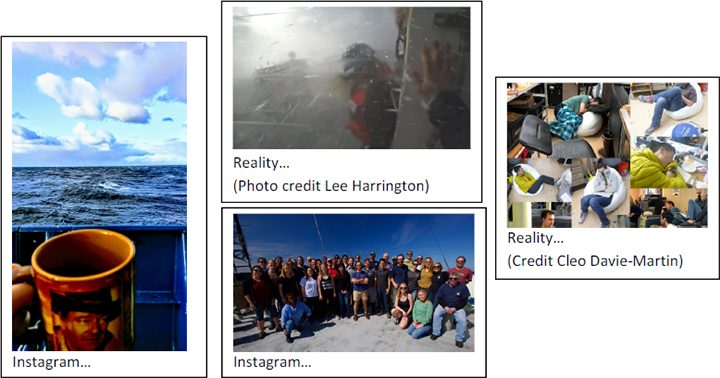
Expected versus the reality of a research cruise
The other morning I found myself chatting in the lab with Ben and Kay, wondering what to write about. A prompt of “what do you do all day?” led to explaining there is really one goal I am setting myself out to achieve on any given day, week, or cruise. And I’m still waiting, nearly 10 years later, to really achieve it. The one goal I thought I almost had within my grasp on a few occasions, but the sea and the universe undoubtedly found a way to thwart in some way or another. Boredom. What? Who has that goal? Who wants to have a boring job? What’s wrong with this girl, is she crazy? But to me, it means nothing is broken that I have to figure out a way to fix in the middle of the ocean. It means a full night’s sleep with no unexpected wake up calls. It means I don’t have to hang on for dear life to avoid getting tossed out of the shower in the morning. It means I know what I am going to work on that day and have no reason it won’t be done by the end of the day. In the last week alone, I’ve woken up each morning thinking I’m in for just another day with my favorite NAAMES crew. And then while recovering the optics instruments I end up wetter than when I stepped out of the shower a few hours before. And then there’s been a shift so we decide to drop what we’re doing and take off for the next station. And then a false alarm goes off in the fire system. And then there’s a major equipment failure that leaves us drumming up every ounce of creativity on how we are going to accomplish the rest of the scientific mission. And then 50 knot winds kick up, throwing everything on the ship, literally and figuratively, for a loop. Are you beginning to see where I’m coming from when I say I could really stand to have a boring day once in a while? (It’s my ½ birthday today, maybe today will be my lucky day? Hi Mom! Hi Dad! Happy Anniversary! I digress…).
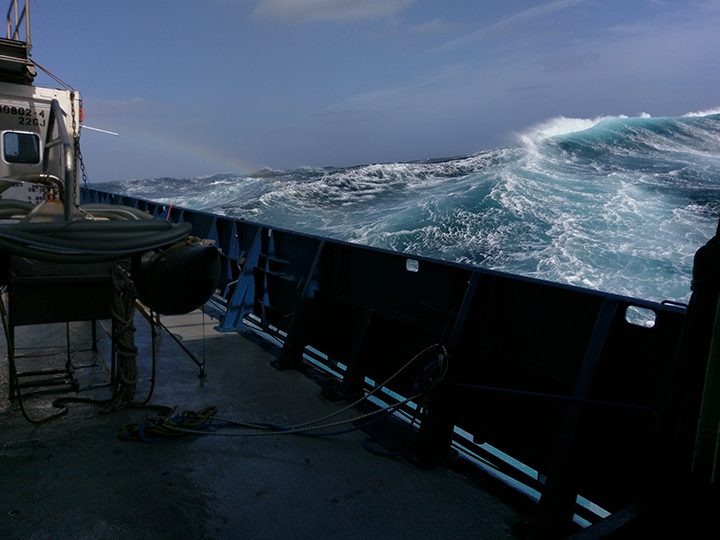
The best laid plans, thrown for a loop
As much as I kid about longing for an Office Space-like existence where my biggest worries are the TPS reports I might have to come in on Saturday to finish (I come in every Saturday, it’s not optional) and a printer that perpetually displays “PC Load Letter” (I already have one onboard that says that), being present and contributing to some of the most inspired research around is a truly humbling experience that I can’t believe I’m lucky enough to be afforded. Even more than the research that might one day make the news (I confess, it is beyond sweet to be able to point to an article and say “I was there, I did that!), it is the everyday conversations and discoveries that pique my curiosity and un-bore-ify (I make up words, it’s a hobby) my life at sea the most. The people and the instrumentation that NAAMES brings together ensures a never-ending dose of the kind of excitement that I don’t mind coming along in an atmosphere where you can’t help but get caught up in it. In the same past week I described above, the aerosol teams detected some of the cleanest air on earth, where of all things, I’m most amused by the fact that the air is too clean to have my hot coffee produce any steam when I walk outside. During humdrum CTD cast #9 of this cruise, we profiled nearly 65 degree Fahrenheit water mixed down to a depth of 600m…in the North Atlantic…in winter. I’ve literally seen thousands of CTD casts in my life, and I’ve seriously never seen anything like that. And those 50+ knot winds we saw a couple times this week? I’m from California where any deviation from sunny and 75 degrees makes headline news, so it’s really in the lousiest of weather that I’m always the first person outside watching the show.
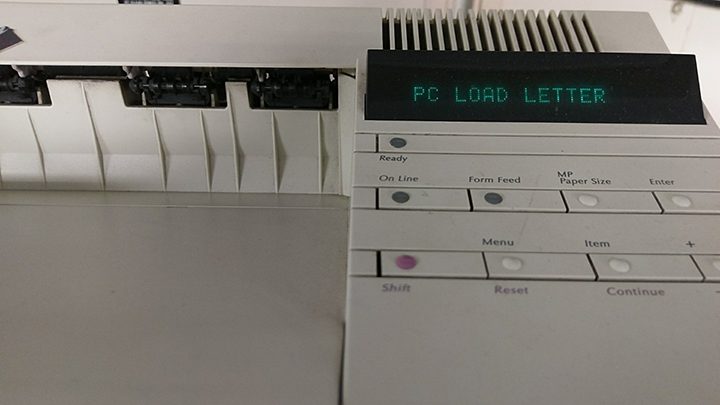
The struggle is real
This -something new around every corner- is the nature of the sea-going business. No one can possibly predict what the final week of NAAMES will bring to the Atlantis, the scientists, and the crew aboard. No telling what papers might come out of the research or what new questions or projects will be spawned, or what “remember when” stories the crew will still be telling about NAAMES in the years to come, but I’m pretty sure no one will tell you coming out here to study the North Atlantic was boring.
Written by Catie Graver (SSSG Technician)
Sleeping on a ship…
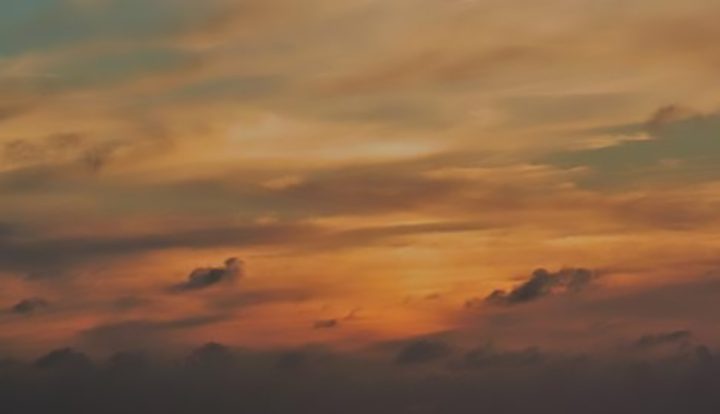
Sunsets on board the R/V Atlantis
Sleep. We all need it. But how much do we actually need? As I’ve discovered the past couple of days, half an hour just won’t cut it! I became a grumbling, tired zombie – an absolute pleasure to be around (not…). Throw in an extra 2-hour post-second-breakfast nap, however, and I found myself marginally above the lower bounds of “functional”.
During the main science transect, particularly station days, most of us find ourselves trying to adhere to obscure sleep schedules – and it usually doesn’t come close to the “required” 8 hours per night (or day, if that’s how your schedule rolls). Myself? I usually sleep from 8 pm until 2 am and rise in time for the first overboard deployments of the CTD rosette. For many, 6 hours of sleep is realistically about all you can hope for on a station day. But existing on 6 hours of sleep a night is not something I could sustain for the entirety of the cruise… Instead, I have adopted the aforementioned post-second-breakfast nap from 8:30-10:30 am. It is a luxury, for sure! I sit down to fresh pineapple and a full cooked breakfast, then I climb straight into bed. Ah, bliss – those are my favorite hours of the day! Nothing can top the splendor of a few stolen quick winks. Not even a pod of pilot whales playing around the bow. Not even our pet brown boobie preening itself atop the balloon shed. Not even a successful balloon launch facing straight into a rising sun under beautifully calm conditions. Not even bobbing up and down at the railings of the second-floor deck ducking behind massive waves of spray as they careen over the bow. Ok, I lied. Maybe the latter could win out…

Sunrise balloon launches, brown boobies, and waves crashing over the bow
The first week or so of the trip, we were treated to warm, sunny weather and calm seas. But in the past week, the seas have taken a turn for the worse (or more “interesting”, depending on your perspective). There is nothing quite like propelling yourself into the top bunk on the O3 deck to the roll of the waves. Timing is everything! We won’t even mention the various approaches for ejecting oneself from the top bunk – some of those involve broken toes (ay Jason?). One might think that we would be gently lulled to sleep by the slop of the waves. In 5-foot seas, that may be true. But when the 20-foot seas roll in, sleep is out of the question! If you lie on your side, prepare to be promptly thrown from your bunk. If you lie on your back, be prepared to withstand the G-forces thrusting your stomach contents back up towards your throat every few seconds. One second, you are light and airy; the next, you weigh 50 tons and you need all your strength just to lift your limbs off the bed. Some might argue that lying on your stomach is the most stable option (think starfish). I would agree – that is, if you enjoy having the pressure of your body smooshing your eyeballs into the pillow – it’s enough to give anyone a headache! Luckily, there are some work-arounds that we can adopt to make sleep more practical. For those of us on the top bunk, life jackets stuffed under the edge of the mattress help wedge us in place – no more falling out of bed and restricted rolling. Tucking your sheets in tightly around you can also be used with moderate success (but requires diligence and continued effort to employ daily). Drugs? Drugs can sometimes help, but taking a sleeping aid and having to rise for sampling 3 hours later aren’t really cohesive options.
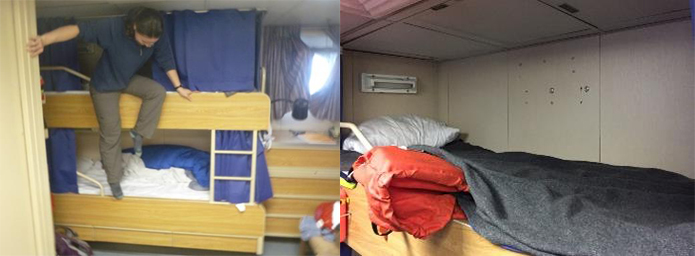
Proper bunk exist strategy (right) and the life-vest strategy to overcome mid-sleep bunk ejection (left)
For those of us on the O3 deck, the rolling waves aren’t all that we have to contend with. Perhaps the most infuriating night of my life was at our northernmost station during NAAMES_2. Every 2 minutes (yes, I timed it) for literally the entire night, the fog horn (situated right outside my window) blasted an obnoxious “bruaump”. Nothing can contend with that! Nothing! The lower decks don’t come without their share of noise either. In the outer rooms, the waves crashing into the side of the boat provide the music of the night. The inner rooms are subjected to the consistent, mind-numbing thud of the bow thrusters. Noise cancelling headphones and music are key (fighting inescapable noise with more noise)!

Some people know all the best sleeping spots!
So how do we cope? For me, exhaustion usually sets in after a few atrocious nights of sleep and I just pass out in my bunk. Otherwise, opportunistic naps. Lots and lots of opportunistic naps! Any location is fair game – the library, on the floor, during science team meetings, in the lab, the back deck… Now, it’s not all so dire. In the calmer southern waters nearer to Puerto Rico and often when we get closer to Woods Hole, we are gently rocked to sleep by calmer seas. Our transit days usually allow for “normal” work hours, increased leisure time, and glorious, glorious sleep! So, can we head home now? I’m looking for some sleep…

The many sleeps of science.
Photo contributions: Myself, Bryce Penta, Kim Halsey, Pete Gaube, Eric Moore, Lee Herrington
Written by Cleo Davie-Martin
Back when I was in Boy Scouts, my troop would spend the better part of a week at summer camp doing Scout things. Tying square knots, whittling sticks, trying to swim, not showering. Pretty typical stuff. To spice things up a bit, my buddies and I would go down to the Trading Post in camp where they sold every type of candy and sweet thing I couldn’t get my hands on back home. It was awesome. I would trade a dollar, and whabam, I would get my favorite treat, a Choco Taco, in return. And the best part of this Trading Post was that they never ran out of Choco Tacos. My parents would give me $20 for the week and I would spend every dollar on this pseudo ice cream delicacy. You might be doing some math right now and say, “Wow, that’s like nearly 3 Choco Tacos a day,” and you know what, you’re not wrong, that math checks out.

Klondike Choco Taco
It had been years since I had eaten a Choco Taco at summer camp so I was stoked when on the last cruise, AT38, I discovered there was virtually a limitless supply of Choco Tacos in the galley freezer. I swear it was like meeting a long lost friend or something like that. And just like old friends can pick up where they left off, I was eating at least three of those things a day, for old times’ sake. One day I ate five I think. I blacked out from all the happiness and sugar.
Among the many things I was looking forward to on this cruise, AT39, crushing tons of late night Choco Tacos was at the top of my list. So my disappointment was palpable when I discovered there were none on the boat. Zero. After a rough few days moping around responding to the ritual morning question “How did you sleep last night?” with “There aren’t any Choco Tacos on the boat, but it’s okay, I think I’ll make it, but you should probably check on me every few hours just to make sure I’m okay,” I came to terms with my new life.
And you know what, life on AT39 has been great. I’ve learned a lot from my Choco Taco experiences on the last two cruises. Importantly, I’ve discovered that the presence or absence of Choco Tacos doesn’t need to dictate my life and that I am fully okay putting a lot of chocolate syrup in my coffee instead of eating ice cream. In life you’re going to be thrown a few curveballs and you just gotta find a different sugary treat to fill in the gap.
In a lot of ways, I see many parallels between my Choco Taco enlightenment and the way the scientists on the boat have been able adapt their science to the constantly changing plans dictated by the ocean conditions we’ve experienced so far. As I write this, we have had to abandon our original plan and steam south to avoid a large storm at our northern stations. And the cool thing is that everyone is putting chocolate syrup in their coffee, metaphorically but likely physically as well. On our retreat yesterday from the storm at Station 4 back to Station 2, we were able to cruise through a super cool eddy that we all got excited about. The fluorometer was the highest it has been all cruise, the ocean temperature was jumping up and down 4 degrees C, and you could actually see the ocean go from a deep blue to a green where a bloom was occurring. And now that we are back at Station 2 we are all quite excited to see how the ocean has changed since we left it a week ago, a unique opportunity we otherwise would not have been afforded if we stuck to our original plan.
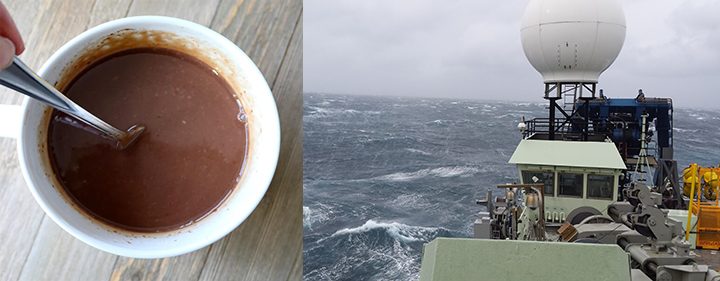
The parallels of substituting choco tacos with chocolate syrup in coffee and adapting the science plan due to storm conditions.
As we sit on Station 2 and prepare for the last 3 days of sciencing really hard, I wonder if my shipmates have had similar insights into the mysteries of life due to the absence of their favorite ice cream on the ship. It also has me wondering, with the calm and collected ability of our chief scientist to make the most out of the latest ocean conditions, is it possible Mike ate all the Choco Tacos?
All the best.
Written by Brian VerWey
50 Things I Worry About
If we are defined as humans in part by the things we choose to worry over, let the following list be a window into the psyche of a Mate on a research vessel, and a portrait of a modern sailor in the style of Picasso.
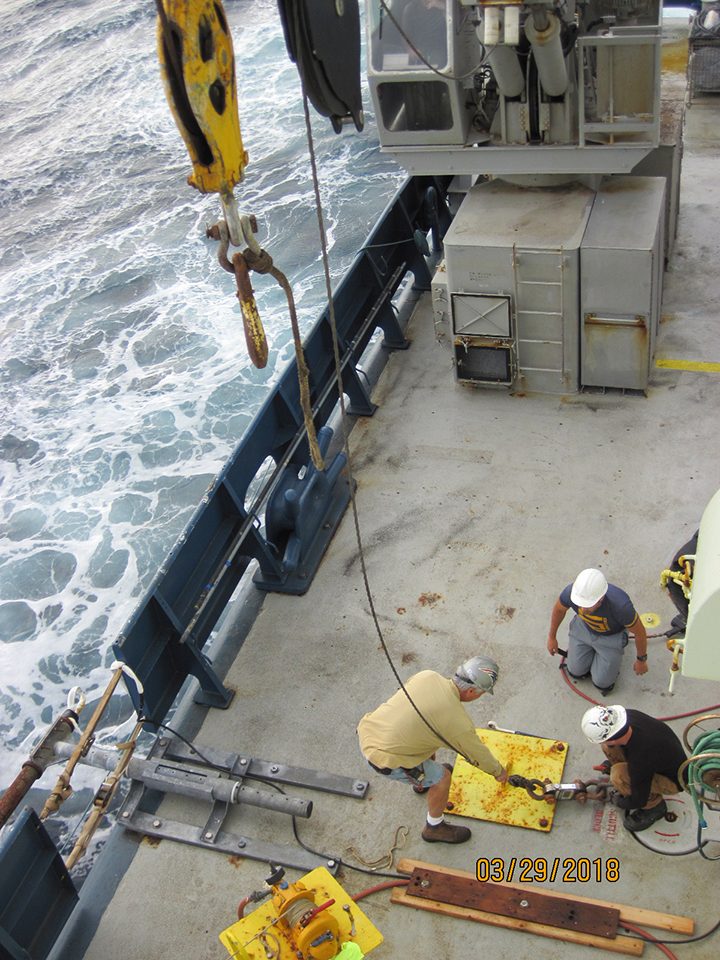
Deck department conducting pull test on trawl wire termination.
Written by Jennifer Hickey (Chief Mate)